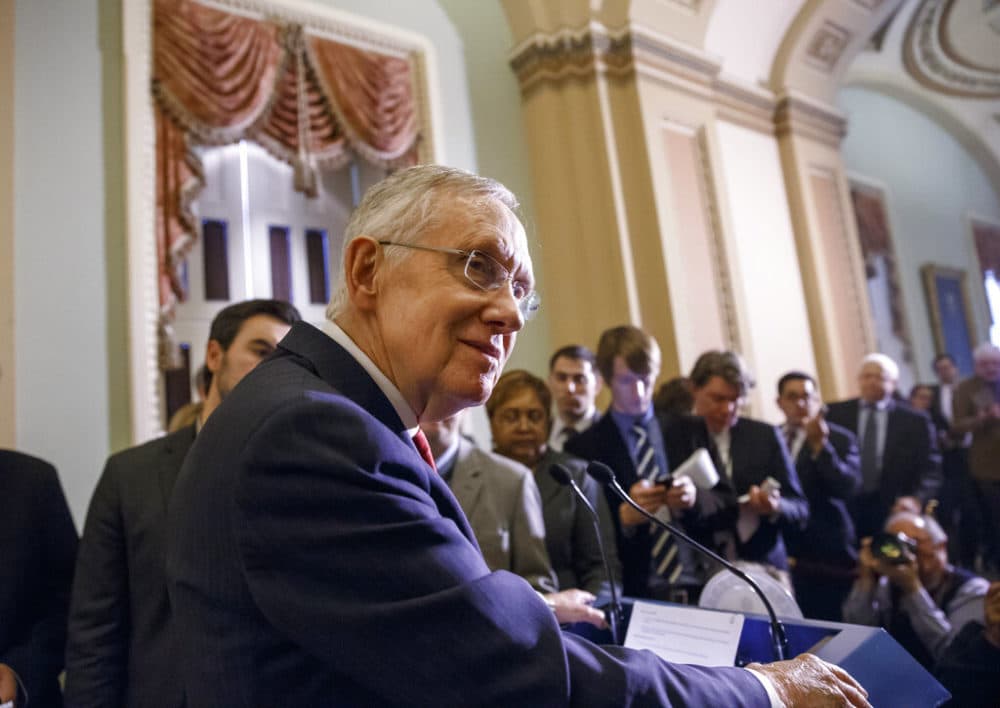Advertisement
Dear On Point:
Radio Diary: A Walk Through The History Of The Filibuster
Resume
On today's program, we discussed the filibuster in the United States Senate. There's a ton of debate going on right now about whether to keep or abolish the filibuster.
And as the debate turns on, there's a sense that the filibuster has been part of the procedures of the United States Senate since time immemorial. But we actually wanted to learn whether or not that's true.
Listen or read along to the transcript below to learn more.
Show Transcript
DAN HOLT: "People tell the history of the Senate that emphasizes things like protection of minority rights, insolation from Democratic pressures. And these are things that were part of the founding goals of the Senate. What they didn't have was the filibuster in the way that we think about it.
"Filibustering is frowned upon as a breaking of the norms of decorum and legitimate debate. And this goes all the way back to the founding where it was dilatory speechmaking and motions and things of that sort are frowned upon. That's why they're called filibusters. But there's also a norm in the 19th century of the ability to pass legislation by a majority. Like there's no assumption throughout the 19th century that you need two-thirds in order to pass legislation."
MEGHNA: So this is Dan Holt. He's an associate historian in the Senate Historical Office in Washington. And we asked him to walk us through the history of when the filibuster was first created, how it was used, what it was good for and what it stopped. It's a fascinating story. And he's here to share it with us.
DAN HOLT: "1890s and then into the first decades of the 20th century is when the filibuster starts to become more widely used. One of them is in 1908 when Senator Robert La Follette of Wisconsin launches what, at that point, is the longest speech in Senate history of about 18 hours to block a currency bill that he thought as too beneficial to Wall Street.
"And then the one that really is the tipping point is in 1917, when a small handful of Republican isolationists successfully blocked a bill that would have armed merchant ships, as a preparation for World War I. That creates a public uproar, especially on the part of President Woodrow Wilson, who called for the Senate to adopt some kind of measure to allow a majority to close off debate.
"When they adopt that rule, however, it sets a very high threshold to be able to bring debate to a close. The ironic thing about the cloture rule of 1917 is that in setting this threshold, it starts to actually normalize the process of slowing things down.
"In fact, the filibustering becomes so prevalent that in 1926, Vice President Charles Dawes unleashes a torrent of criticism at the Senate for its rules that allow so much delay. In 1926, you see a filibuster against the United States signing on to the World Court. And again, this is isolationist.
"Republicans are behind this one. Far and away, the most important filibusters deal with anti-lynching legislation in 1922 and then again in the late 1930s. And then during World War II era, in the 1940s, you get Southern Democrats blocking bans on the poll tax. They block strengthening the Fair Employment Practices Commission that had been created.
"Going forward into the 1950s, you get filibusters on civil rights legislation in 1957, 1960, finally into 1964. So in the public mind, the filibuster really does become a tool of Southern Democrats hoping to maintain white supremacy and block voting in civil rights for African Americans in the South.
"The most important change in the rules of the filibuster came in 2013 under Democratic leader Harry Reid, and that was the so-called nuclear option. In the early 2000s, you start to see Democrats who are willing to delay or block nominations for the judiciary.
"And so this is when Bill Frist, Republican leader at the time, coins the idea of the nuclear option, which would be to essentially use complicated parliamentary methods to lower the threshold for cloture. In 2003, the Republicans and Democrats reach an agreement to move forward on those nominations without triggering the nuclear option.
"By 2013, during Obama's administration, the number of cloture motions and votes skyrockets. Such that in 2013, the Democratic leader, Harry Reid, decides that he's going to exercise the nuclear option. And what the nuclear option does is it allows for a simple majority to invoke cloture on lower court federal nominees, judicial nominees.
"But you know, what's really key about that is once you take that step, you've now set, essentially, a precedent for taking that step in the future. Such that when the Republican majority entered in 2017 and there was a opening on the Supreme Court, they then said, Well, this has been done before. We are going to use that nuclear option to get around Democratic obstruction on Cabinet appointees and Supreme Court nominees.
"And so that leaves us where we are today, where everyone understands that there is this parliamentary method for doing away with the filibuster. So what you end up having then is ... the debate that we're in now about what are the costs and benefits of the majority using that tool for regular legislation?"
MEGHNA: So [a] walk through U.S. Senate and filibuster history from Dan Holt, associate historian in the Senate Historical Office.
Hear the full hour on the fight over filibuster reform here.
This segment aired on March 10, 2021.

